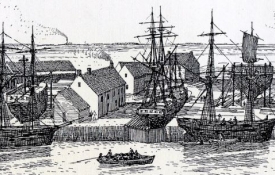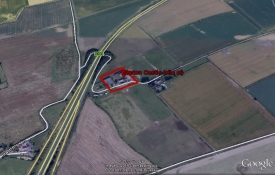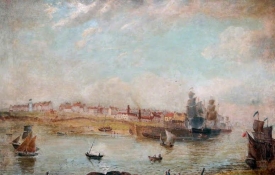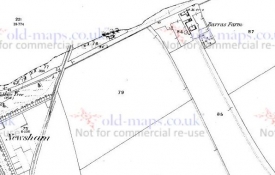Welcome to the Community View section of the website. This area is dedicated to articles of interest, community information and local topics that are submitted by members of the public or guest writers. It is also the main section dedicated to the Youth Media Group Project.
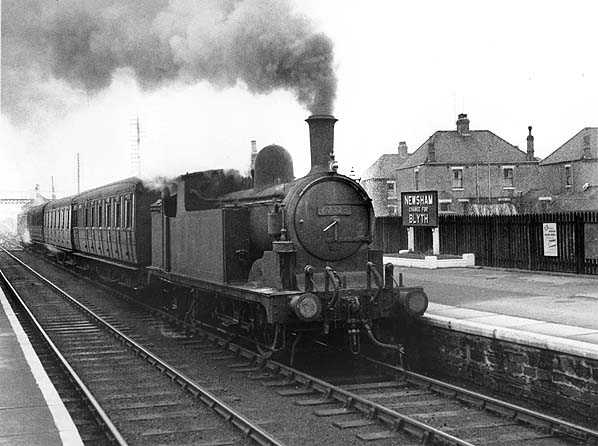
From one of a series of articles published in the Newcastle Chronicle in 1872 called "Our Colliery Villages":
Newsham has a stationmaster, and the Station master has lungs and also a voice, which he is not afraid to use when the occasion demands. Now timid travellers who have to negotiate junctions in the course of a journey feel very uncertain as to the place of change; nervous old ladies, bearing a general resemblance to the illustrious Mrs. Gamp (drunk nurse from Martin Chuzzlewit by Charles Dickens) clutch their baggy umbrellas wildly, gather up their parcels eagerly, and prepare for changing carriages at many a station before they reach the junction. Nor is this fear of making a mistake altogether groundless, for railway porters and guards never waste much of the sweet music of their voices in calling out the names of stations.
If there is one station on the Blyth and Tyne Railway which is unmistakable, and about the identity of which there can be no mistake, that station is Newsham. There is a sort of general likeness about other stations. Even junctions are somewhat like each other, but Newsham junction is most assuredly not in the least like any other junction in the kingdom. At all events, it is to be hoped there is not such another. Let us not be too hard upon Newsham, however, for it certainly does possess one advantage over most other junctions, and that advantages not a very slight one either.
Even when we do hear one with the voice of a stentor, he generally bawls in an unknown tongue, and runs the name of the place into a mysterious word of twenty or thirty syllables. Therefore, when we find a rare stationmaster who sings both “loud and clear” let us make much of him.
The station master at Newsham is its strong point; then he, in fact, is Newsham Junction; and the most timid of travellers, provided he or she is not deaf or very stupid, need be under no apprehension of missing this junction. For as soon as the train draws up at the platform a voice is heard. None of your still, small voices, none of your shrill piping voices, but a big, burly Northumbrian voice, thundering out with immense energy, beating, as it were, on the very drums of one’s ears.
“Newsham, change for Blyth, Newsham, change for Blyth.”
Blyth and Tyne directors are decidedly economical as to their stations, and Newsham is no exception to the general rule. Indeed, considering the amount of traffic at Newsham, it is worse than most of the other stations. It has no waiting room except the one in which the public is supplied with tickets, and its capacity is very limited indeed.
Then Newsham is not very far from the sea, so that on bleak wintry Saturday nights, when the little room is packed, and there is but little standing room on the exposed platform, colds are plentiful, and if curses could spoil dividends, the company might at once appoint official liquidators.
Newsham is a very historical locality, and, if we are to believe the records of local historians, derived its name from some knight who came over from Normandy in the train of the Conqueror, so that it can boast of a pedigree of which many noble families would be proud.
We must shut our “historical conscience,” however, and inspect Newsham as a colliery village. As a colliery village Newsham belongs to colliery owners who have always shown themselves anxious and ready to promote the social welfare and comfort of their numerous workmen; but Newsham and Cowpen are merely step-children of the Cowpen and North Seaton Coal Company.
They contrast very unfavourably with their younger relations across at Cambois and North Seaton. The two latter places have been as it were built up under the fostering care of the respected head viewer of the company, whereas Newsham and Cowpen were built long before Mr. G. B. Forster long-standing and enterprising viewer of Cowpen collieries) exercised his present enlightened sway over this part of the Northumberland coalfield.
Newsham, then, is a combination of the ancient and modern - ancient as to its pit cottages and roads, modern as to its tenemented property and conveniences. When the pitmen’s houses of Newsham were first built privies were considered quite unnecessary; but since the place came into the occupation of the present company, privies and ashpits have been added, and the old stagers of the place are gradually becoming accustomed to their use.
It must be confessed, however, that the condition of many of the privies behind some of the rows is in the highest degree discreditable to the inhabitants of the houses to which they belong. And is such that when the warm weather sets in, the inhabitants, instead of being able to inhale the mild breeze of spring through the open doors and windows, will simply breathe a filth poisoned atmosphere, laden with the seeds of ill-health and disease.
When the present superintendent of the Blyth and Tyne Railway came down to overhaul the line in the vicinity of Newsham, it was before the reign of sanitary law had commenced. He observed opposite to the door of every house facing the line a gap in the hedge, and a corresponding gap in the hedge at the opposite side of the line. This state of things naturally attracted his attention, and in answer to his inquiries, he was told that these gaps were the doors to the pitmen’s privies.
A suggestion was also made to him as to the best means of stopping this kind of trespass on the sacred property of the Company, which not only possessed the merit of being original, but illustrates humorously the strong objection which many pitmen entertain to the crossing of the stile. He was told the best way to stop these systematic incursions was to erect a stile wherever there was a gap.
The only excuse there seems to be for the disgraceful state of many of the privies is the fullness of the ashpits, many of which are running over, and stand greatly in need of carting away.
The colliery houses at Newsham are mostly of the old uniform type - one room down and one room up, the upper storey being attained by the usual old-fashioned ladder. Until lately the upper rooms of these houses had no ceiling but the slates; but recently they have been ceiled with lath and plaster, and are now much more comfortable than they used to be.
The best features of Newsham are the openness of the rows, and its nearness to the sea, and there can be no doubt that the salt breezes which blow fairly through the place are a great advantage and carry away much that is unwholesome.
In addition to the colliery rows, Newsham boasts of a street, which rejoices in the name of Front Street, and which we should say houses a larger number of tenants than any other two-storied street of the like dimensions in the district. This street faces the railway, and asserts its independence of conventional forms by the various colours of the bricks of which the different houses are built, looking in this respect like a row of chequers set on edge. These houses are the property of different individuals, and are all let off to numerous tenants, some of them being occupied by six or seven different families.
Houses are bad to obtain in the place, and as a consequence rents are very high. Front Street is in the Cowpen Local Board district, and that this is considered a distinction is shown by the kerb stone which runs all round the street. The front side indeed has been done with concrete, and this must indeed be considered a great step in advance, showing as it does the watchful care which the aforesaid Local Board exercises over even the most remote of its dependencies.
It would be well, however, if this body would exercise its power and cause something to be done at the back of the street, for it is allowed to remain in a very filthy state.
Here is also situated the only chapel of which Newsham can boast, and it is really a very type of the colliery village Methodist chapel. It is the property of the Free Methodist Connexion, and has been named “The Ebenezer,” a by no means uncommon name among the Dissenters.
Newsham, despite its antiquity, has not yet been able to establish a newsroom, though it is able to afford a decent maintenance to no less then five public houses. Nor does co-operation seem to flourish at Newsham, for the New Delaval Society which has its establishment here, though it is now in the eleventh year of its existence, can only number some 288 members on its books.
So far we have seen only Newsham proper; but the pit where most of the inhabitants work is called the “Hannah Pit,” and is at Newsham, about three quarters of a mile away. Before we can go and see Hannah, however, we are invited to go and see the only public cart road leading into Newsham, for it is much worse than any of the other roads in the district, and at the present time is simply impassable.
On the day of our visit, an adventurous potato dealer, making sure of being able to get a load of' about twenty stones of “spuds” into the place, drove gaily along the road in question. But after having got safely over three fourths of the distance, his horse sunk up to the knees, his cart sunk up to the axle-tree, and he was obliged to run for another horse and ropes to get himself out of his difficulties.
The Hannah Pit is not a very large pit, but is a remarkably well arranged one, and finds employment for some 216 hewers, who work out something like an average of 560 tons of coal, per diem. Like many other pits in the district, her ladyship seems to have been hoarding her supplies lately, and an immense heap of the best coal has accumulated near the pit, where it will doubtless remain until it can be got rid of without affecting that extremely sensitive plant, the coal market.
The only public building near the Hannah is a Primitive Methodist Chapel, the envy of surrounding conventicles, for it possesses a harmonium of its own, which is a most wonderful improvement to the singing as well as a great attraction to outsiders.
There are not many houses at New Newsham, and such as there are of a very poor order indeed. They are not provided with privies and the unwholesome ashpits are within four yards of the pantry windows.
